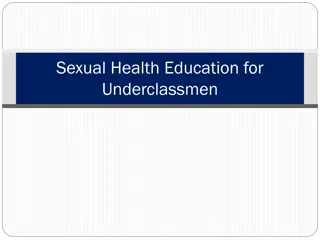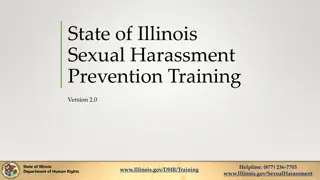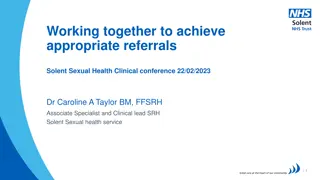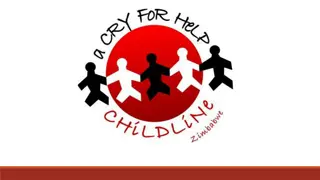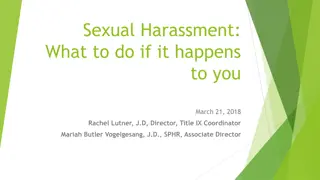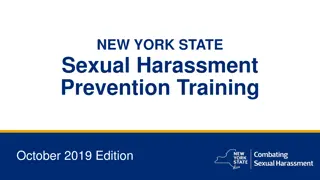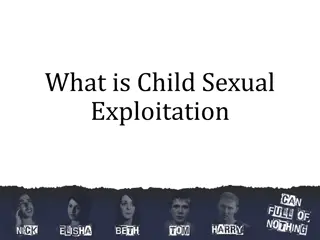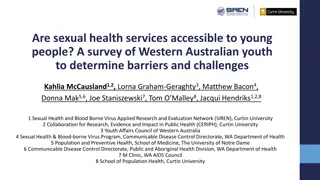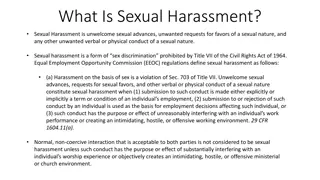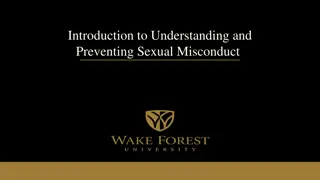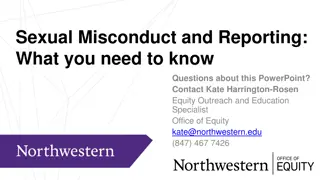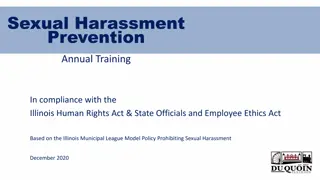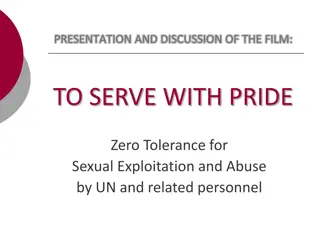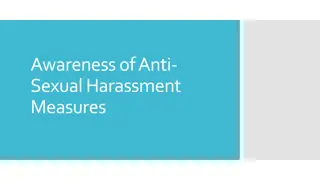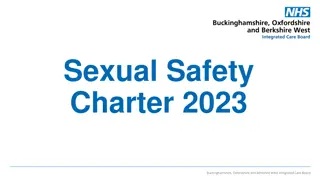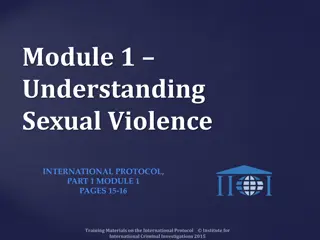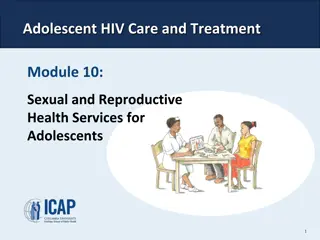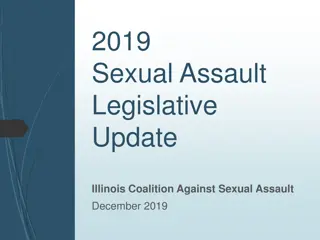Comprehensive Sexual Health Education Overview
The sexual health curriculum overview emphasizes the rights, respect, and responsibilities of youth in receiving honest sexual health information and equitable opportunities. Mandated by the California Healthy Youth Act, the instruction promotes understanding and healthy attitudes about adolescent growth, relationships, and sexuality. Parents/guardians have rights to be notified of and preview instructional materials, as well as excuse their children from the curriculum.
Download Presentation

Please find below an Image/Link to download the presentation.
The content on the website is provided AS IS for your information and personal use only. It may not be sold, licensed, or shared on other websites without obtaining consent from the author.If you encounter any issues during the download, it is possible that the publisher has removed the file from their server.
You are allowed to download the files provided on this website for personal or commercial use, subject to the condition that they are used lawfully. All files are the property of their respective owners.
The content on the website is provided AS IS for your information and personal use only. It may not be sold, licensed, or shared on other websites without obtaining consent from the author.
E N D
Presentation Transcript
Grade 6 Grade 6 Sexual Health Curriculum Sexual Health Curriculum Overview Overview
Rights, Respect, Responsibility The Advocates for Youth s Rights, Respect, Responsibility curriculum is based on the belief that: Youth have the right to honest sexual health information and equitable opportunities to reach their full potential. Youth deserve respect and to have their experiences be valued. Young people have the responsibility to protect themselves. Society has the responsibility to provide young people with all of the tools they need to safeguard their sexual health.
California Healthy Youth Act Mandated by the State of CA. Comprehensive sexual health and HIV prevention instruction must be: Taught at least once in middle school and at least once in high school. Age-appropriate if taught earlier than grade 7 and instruction must align with the general provisions ( 51930-3) and may include any of the general topics ( 51934). Medically accurate, objective, and unbiased ( 51933). Appropriate for use with pupils of all races, genders, sexual orientations, and ethnic and cultural backgrounds, pupils with disabilities, and English learners ( 51933).
All sexual health and HIV prevention instruction must: Promote understanding of sexuality as a normal part of human development. Provide pupils with the knowledge and skills they need to develop healthy attitudes concerning adolescent growth and development, body image, gender, sexual orientation, relationships, marriage, and family. Affirmatively recognize that people have different sexual orientations and, when discussing or providing examples of relationships and couples, shall be inclusive of same-sex relationships. Encourage a pupil to communicate with his or her parents, guardians, and other trusted adults about human sexuality and provide the knowledge and skills necessary to do so. CA Education Code 51933
Parent/Guardian Notification Parent/Guardian Notification You have the right to be notified of the sexual health and HIV prevention instruction that will be held at your school site. Typically a notification letter will be sent home in the beginning-of-the year registration/enrollment packets. Parents/guardians must be notified at the beginning of the school year: Comprehensive sexual health and HIV prevention instruction will be taking place. Curriculum materials are available for parent/guardian preview. You may excuse your child from instruction by providing a written request to the school. CA Education Code 51937-9
Parent/Guardian Rights Parent/Guardian Rights Previewing Materials Excusing Child from Instruction You have the right to preview all sexual health and HIV prevention instructional materials at the school site. In order to excuse your child from the sexual health instruction, you must state your request in writing to the school with a written and signed note to teacher. May preview at Parent Preview event or by scheduling directly with teacher. California requires passive consent for sexual health instruction, meaning if no opt-out note is provided by the parent then the student receives the instruction. Resources for previewing instructional materials are also available on our website. CA Education Code 51938
Curriculum Overview Aligned with National Sexuality Education Standards and CA Ed Code 10 lessons 50-minutes each Taught by trained classroom instructors Activity and skills-based instruction Homework in the following lessons: 1, 2, 3, 5, 6, 8, 9, 10
Lesson Sequence 1. Gender Roles, Gender Expectations gender and gender identity 2. Change Is Good puberty and adolescent development 3. Sexual and Reproductive Anatomy reproductive anatomy 4. Puberty and Reproduction sexual reproduction 5. I Am Who I Am gender identity and sexual orientation 6. Liking and Loving: Now and When I m Older abstinence and ways to show affection 7. Learning about HIV HIV transmission, prevention, and treatment 8. Protecting Your Health: Understanding and Preventing STIs STI prevention 9. Understanding Boundaries setting and respecting boundaries, sexual harassment. 10. Being Smart, Staying Safe Online social media and technology safety
Lesson 1 Gender Roles, Gender Expectations Objectives Activities Students will be able to Name characteristics that are stereotypically attributed to boys and girls. Describe their own feelings about behaviors being ascribed to a particular gender. Students will Brainstorm a list of gender attributes that are typically used to describe boys and girls. Explore which of these attributes can be used to describe the other gender. Reflect on how they might act or do things differently if they were the other gender. Homework: Gender in the World Around Us Students look around their home to try to find examples of things that may fulfill gender role stereotypes.
Lesson 2 Change Is Good! Objectives Activities Students will be able to Name physical, social, cognitive, and emotional changes that young people go through during puberty. Identify age-appropriate online resources that contain medically accurate information about puberty and adolescent development. Students will Brainstorm a list of changes that young people go through during puberty. Categorize the physical, social, cognitive, and emotional changes that young people go through during puberty. Homework: Where Can I Learn More about Me? With a parent or guardian, students will investigate several youth-friendly, age appropriate, and medically accurate online sources that contain information on puberty and adolescent development.
Lesson 3 Sexual and Reproductive Anatomy Objectives Activities Students will be able to Identify and describe parts of biological female and male reproductive systems. Identify reliable and accurate sources of information about reproductive anatomy. Students will Listen to information about reproductive body parts and functions. Color code and label female and male reproductive anatomy diagrams. Homework: Body Parts Students will identify which reproductive body parts are found on female bodies, male bodies, or both, and will identity the function of these body parts.
Lesson 4 Puberty and Reproduction Objectives Activities Students will be able to Describe how puberty prepares the body for the potential to reproduce. Describe the process of reproduction. Identify the correct order of steps involved in conception. Students will Review reproductive body parts and their functions. View diagrams and explanations of the reproductive cycle leading to conception. Organize steps of the reproductive cycle in order and by female or male. Homework: N/A
Lesson 5 I Am Who I Am Objectives Activities Students will Reflect on what they have heard about the term sexual orientation and what they think this means. Listen to a presentation on definitions and explanations of sexual orientation and gender identity. Explore myths and facts about sexual orientation and gender identity. Students will be able to Define the terms sexual orientation, gender identity, and gender expression. Distinguish between factual and incorrect statements regarding sexual orientation and gender identity. Name respectful ways of communicating with or about LGBTQ individuals. Homework: Fix This! and Defining Sexual Orientation Students will watch an online video called Dealing with Difference and answer questions regarding what happened in the video clip and what the student suggests should have happened differently. Then students will have a conversation with a parent about sexual orientation definitions and terms.
Lesson 6 Liking and Loving Now and When I m Older Objectives Activities Students will be able to List non-sexual activities that people can do to show affection. Define abstinence and its connection to pregnancy prevention. Have a conversation with parents about reasons to stay abstinent. Students will Brainstorm who people are that they show affection to and how they show them. Discuss non-sexual ways to show affection. Talk about why it s beneficial to remain abstinent and wait until they are older to show affection with sexual behaviors. Homework: A Conversation about Sex Students and their parent or caregiver will each record their thoughts regarding why people should remain abstinent until they are older and how people might know when they are ready to have sex. Then they will share their ideas with each other and the student will record this conversation.
Lesson 7 Learning about HIV Objectives Activities Students will Brainstorm the difference between communicable and non-communicable diseases. Identify myths and facts regarding HIV transmission, prevention, and treatment. Discuss ways to show affection that cannot transmit HIV to another person. Students will be able to Define HIV. Identify ways in which HIV can and cannot be transmitted. Identify ways to prevent HIV transmission. Describe treatment for HIV+ individuals. Homework: N/A
Lesson 8 Understanding and Preventing STIs Objectives Activities Students will be able to Define STIs and HIV. Name common STIs and how they are transmitted. Identify sexual behaviors that put people at high, low, or risk for STIs. Students will Read specific attributes of different STIs. Identify particular STIs based on descriptions of how they are transmitted and treated. Compare and distinguish between behaviors that put people at risk for STIs. Homework: HIV and AIDS Students go to an online resource to investigate additional causes, prevention techniques, and treatment for HIV.
Lesson 9 Understanding Boundaries Objectives Activities Students will be able to Define what a personal boundary is. Demonstrate how to be clear about one s own boundaries and how to respect others . Define sexual harassment and sexual assault. Name a resource that can provide information on where to report sexual harassment or assault. Students will Discuss will brainstorm the meaning of boundary and when people might set personal boundaries. List examples of personal boundaries. Work through scenarios that address instances of sexual harassment and assault. Homework: What s Your Advice? Students will read scenarios in which a friend is in a situation where they might have to set a personal or sexual boundary and will describe what advice they would give to their friend. They will then discuss their ideas with a parent or caregiver and record any additional advice they might give.
Lesson 10 Being Smart, Staying Safe Online Objectives Activities Students will be able to Describe positive aspects of using social media. Describe aspects of social media that can be inappropriate and risky. Demonstrate an understanding on how to manage risky online situations. Students will View three students uses of social media and list positive and negative aspects of each. Read several scenarios, evaluate the safety of each situation, and discuss how the student might proceed in order to remain safe. Homework: Stay Safe Online! Students create posters to teach other students about the pros and cons of online communication.
Contact Information Contact Information Summer Hellewell Resource Teacher Sexual Health Education Program 4100 Normal Street, Room 2133 San Diego, CA 92103 (619) 725-5583 shellewell@sandi.net www.sandiegounified.org/SHEP Youth Risk Behavior Survey Data: www.sandiegounified.org/YRBS




